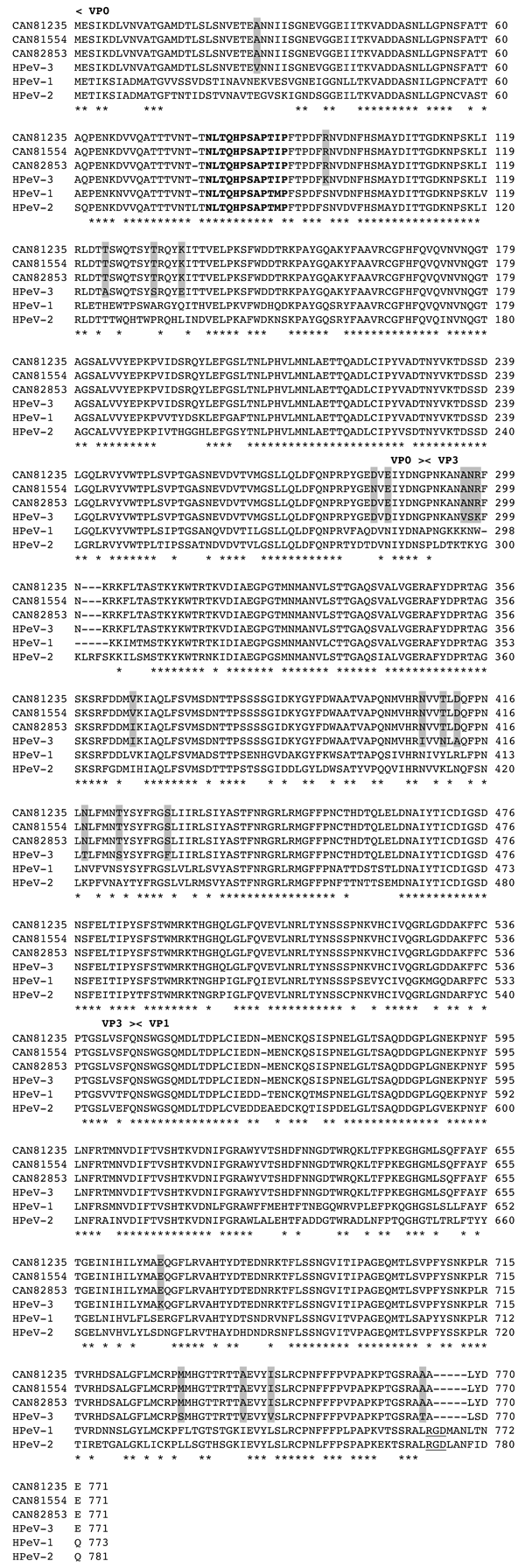Volume 11, Number 1—January 2005
Research
Human Parechovirus-3 and Neonatal Infections
Appendix

Appendix. Figure. Comparison of the predicted amino acid sequences of human parechovirus (HPeV)-3 Canadian isolates no. 81235, 81554, and 82853 with reference sequences of HPeV-1, -2 and -3 (GenBank accession no. S45208, AF055846, and AB084913, respectively) for the VP0-VP3-VP1 proteins (8,10). Asterisks denote identical residues in all strains, whereas shaded amino acids highlight changes between HPeV-3 isolates. The RGD motif present only in HPeV-1 and -2 strains is underlined. The HPeV-1 immunodominant epitope described by Joki-Korpela et al. (15) is shown in bold.
References
- Stanway G, Hyypia T, Knowles NJ, Hovi T. Biological and molecular basis of picornavirus classification. In: Semler BL, Wimmer E, editors. Molecular biology of picornaviruses. Washington: ASM Press; 2002. p. 17–24.
- Wigand R, Sabin AB. Properties of ECHO types 22, 23, and 24 viruses. Arch Gesamte Virusforsch. 1961;11:224–47. DOIPubMedGoogle Scholar
- Joki-Korpela P, Hyypia T. Parechoviruses, a novel group of human picornaviruses. Ann Med. 2001;33:466–71. DOIPubMedGoogle Scholar
- Joki-Korpela P, Hyypia T. Diagnosis and epidemiology of echovirus 22 infections. Clin Infect Dis. 1998;27:129–36. DOIPubMedGoogle Scholar
- Stanway G, Joki-Korpela P, Hyypia T. Human parechoviruses—biology and clinical significance. Rev Med Virol. 2000;10:57–69. DOIPubMedGoogle Scholar
- Koskiniemi M, Paeteau R, Linnavuori K. Severe encephalitis associated with disseminated echovirus 22 infection. Scand J Infect Dis. 1989;21:463–6. DOIPubMedGoogle Scholar
- Figueroa JP, Ashley D, King D, Hull B. An outbreak of acute flaccid paralysis in Jamaica associated with echovirus type 22. J Med Virol. 1989;29:315–9. DOIPubMedGoogle Scholar
- Ito M, Yamashita T, Tsuzuki H, Takeda N, Sakae K. Isolation and identification of a novel human parechovirus. J Gen Virol. 2004;85:391–8. DOIPubMedGoogle Scholar
- Cote S, Abed Y, Boivin G. Comparative evaluation of real-time PCR assays for detection of human metapneumovirus. J Clin Microbiol. 2003;41:3631–5. DOIPubMedGoogle Scholar
- Berchovich S, Pangan J. Recoveries of virus from premature infants during outbreaks of respiratory disease. The relation of echovirus type 22 to disease of the upper and lower respiratory tract in the premature infant. Bull N Y Acad Med. 1968;44:378–87.
- Rotbart AH. Enteroviruses. In: Richman DD, Whitley RJ, Hayden FG, editors. Clinical virology. Washington: ASM Press; 2002. p. 971–94.
- Sato N, Sato H, Kawana R, Matumoto M. Ecological behavior of 6 coxsackie B and 29 echo serotypes as revealed by serologic survey of general population in Aomori, Japan. Jpn J Med Sci Biol. 1972;25:355–68.PubMedGoogle Scholar
- van den Hoogen BG, de Jong JC, Groen J, Kuiken T, de Groot R, Fouchier RA, A newly discovered human pneumovirus isolated from young children with respiratory tract disease. Nat Med. 2001;7:719–24. DOIPubMedGoogle Scholar
- Joki-Korpela P, Roivainen M, Lankinen H, Poyry T, Hyypia T. Antigenic properties of human parechovirus 1. J Gen Virol. 2000;81:1709–18.PubMedGoogle Scholar
- Boonyakiat Y, Hughes PJ, Ghazi F, Stanway G. Arginine-glycine-aspartic acid motif is critical for human parechovirus 1 entry. J Virol. 2001;75:10000–4. DOIPubMedGoogle Scholar
- Joki-Korpela P, Marjomaki V, Krogerus C, Heino J, Hyypia T. Entry of human parechovirus 1. J Virol. 2001;75:1958–67. DOIPubMedGoogle Scholar
Page created: June 16, 2011
Page updated: June 16, 2011
Page reviewed: June 16, 2011
The conclusions, findings, and opinions expressed by authors contributing to this journal do not necessarily reflect the official position of the U.S. Department of Health and Human Services, the Public Health Service, the Centers for Disease Control and Prevention, or the authors' affiliated institutions. Use of trade names is for identification only and does not imply endorsement by any of the groups named above.